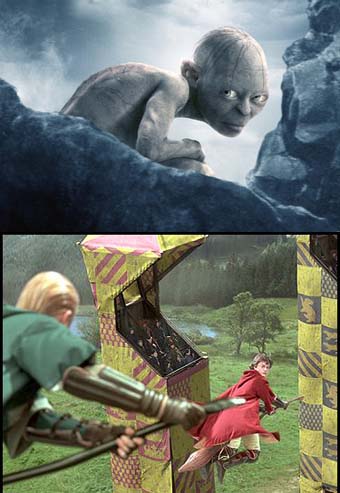
FX: Who Do You Trust?
An increasingly large part of the post-production work has to do with what we still call "special effects." It's a bland term for an ever-growing inventory of devices to manipulate both image and soundtracks.
We've already made the differentiation between editing (horizontally, on the timeline) and mixing (vertically, combining parallel tracks). Until recently, mixing was limited to the soundtrack, but as the editing process has been digitized, mixing becomes more and more important to the picture track, too. Such mixing is usually referred to as "FX" (short for special effects).
Visual mixing has existed since almost the beginning of movies. Rear projection, its more effective successor front projection, glass and matte shots, and model shots (all of which you learned about in the reading assignment for this lesson) date back to the Golden Age and before. We can appreciate the ingenious technology behind these techniques. But once the image had been digitized, such visual mixes became far easier to accomplish. So easy, in fact, that we are entering a new age of cinema in which the truth of the image can no longer be trusted.
 |
||
| Woody Allen used analog techniques to matte real people into historical environments in 1983's Zelig. Here, Zelig (Allen) waves behind Adolf Hitler's back. | ||
The turning point was the 1992 Diet Coke commercial in which a young Gene Kelly danced with pop star Paula Abdul. The commercial incorporated an image of Kelly in his 30s, even though at the time of the commercial's release, the real Kelly was around 80 years old. The effect was seamless, though. Kelly danced with Abdul like they were same-aged peers. The precursors to this blending of real and digital were Woody Allen's Zelig (1983) and Carl Reiner's Dead Men Don't Wear Plaid (1982), two films that first experimented with these combination techniques using analog technology.
Once you've digitized the image, you can do just about anything to change it. The ultimate result is the effect that has come to be known as a morph. (The most celebrated morph films are Terminator 2, which introduced the technique, and The Matrix, which exploited it as a central plot element. The John-Landis-directed music video for Michael Jackson's "Black or White" also used the morph to memorable effect, fluidly transforming male faces to female ones, while simultaneously altering the ethnicity and structure of the faces. Interestingly, morphs did exist before the digital age (think of Beauty and the Beast), but they were so difficult to do that the trick hadn't been named. You had to shoot a frame, add or remove a bit of makeup, shoot another frame, add or remove more makeup, and so on. You can see why few pre-digital morphs lasted longer than a few seconds.
Carl Reiner's clever intercutting between live actors and old footage in Dead Men Don't Wear Plaid and Woody Allen's equally ingenious matting in of Zelig's image in historical scenes suggest what is in store for us as digital cinema matures. It is only a matter of time (and gigabits) until the software is sophisticated enough to re-create both the image and the voice of, say, Humphrey Bogart, so that the great film star, dead since 1957, can romance Christina Aguilera (or more likely, her daughter) in a remake of Roman Holiday or ride shotgun with Chewbacca in Star Wars 34: The Empire Strikes a Pose.
This infinitely manipulable image track is going to open up a lucrative new area for copyright and trademark lawyers (but that's more a subject for Lesson 8).
All of this image reworking (as well as more mundane matters like color timing, or matching the color balance in scenes shot at different times and places) is now referred to in the industry as computer-generated imaging (CGI). CGI, as well as other aspects of post-production, is accomplished at a post house, a company that specializes in these effects. Some post houses are boutiques, offering specialized services in only certain areas, such as digital effects. Other post houses are one-stop shops with the ability to handle just about any aspect of post-production for a project―CGI, editing, title design, mixing, etc.
The bottom line is this: FX used to be remarkable, ingenious tricks of cinema, used sparingly. Technicians would win Academy Awards for inventing new approaches like front projection. We would marvel at them. CGI, though, is far more effective than analog FX ever were, and is available to any one who purchases and practices using the latest software.
The result is that you can no longer trust, at any level, what you see. This marks a major change in our culture of film. It will be interesting to see how we cope with it.
The Industry
 |
||||
| The Lord of the Rings and Harry Potter are two film franchises that fit the three currently dominant requirements: they're effects-heavy, they have built-in sequels, and they're geared toward younger audiences (although older audiences like them as well). | ||||
As we suggested in the previous section, film is a medium of expression that is available to almost everyone now. Thirty years ago, very few of us shot 8mm home movies. Today, on the other hand, many households have hundreds of hours of home videotape sitting on the shelf. But that's not the "film" that interests us most. We are focused on feature films, whether they are products of Hollywood or independent filmmakers. Paradoxically, as the medium has opened up to millions more, the industry itself has become narrower and narrower.
Ted Demme and Richard LaGravenese's eloquent documentary A Decade Under the Influence (2003) describes in sophisticated detail what the film scene was like in the early 1970s. This was a period of enormous experimentation. The moguls of the Golden Age were gone, and there was an "anything goes" feeling in the air. That second great age of American cinema lasted less than 10 years. You could say it started with Bonnie & Clyde (1967) and ended with Star Wars (1977).
Certainly, George Lucas did not intend to put a period to a lively age of filmmaking with his prodigious paean to old Hollywood. But what happened after was that the businesspeople in Hollywood reasserted control. And - surprisingly - Lucas's masterpiece provided a golden roadmap to the future. It appealed to adolescents. It was effects-rich. And it was a "franchise" film.
Because the odds of success in Hollywood are so minimal, filmmakers and studios are always looking for a franchise film, a movie that lends itself to numerous sequels. The champion so far must be the James Bond franchise, dating from 1962 and still going strong after 40 years and five stars (six, if you count David Niven as Sir James Bond in 1967's Casino Royale). But there are many others. Lucas had designed Star Wars from the beginning as a series of three trilogies. Perhaps unconsciously (or consciously), he understood the economic value of a franchise film.
We've already talked about the current dominance of effects. Kubrick's 2001 may have set the pattern, but Star Wars solidified the magical image as the way of the future. It was clear this was what audiences wanted to buy from now on.
However, the most important new rule that Star Wars established was the dominance of the teenage and young adult audience. Lucas was recalling his own memories of great science-fiction serials of the 1930s, such as Buck Rogers and Flash Gordon, with affection and style. (Of course, Lucas had been exposed to this type of film on television in the 1950s, not on Saturday mornings in the theater in the 1930s.)
|
The
Author Reflects: In 1979, I was dabbling in film production. I bought an option on the true story of a guy named Frank Abagnale. My friend, screenwriter Stuart Rosenberg, wrote a treatment of the story. We called it "Above the Line" (although I don't know why we called it that). We sold this treatment to Bud Yorkin. Yorkin was Norman Lear's former partner and, as a result, had oceans of money. (He didn't share it with us.) Eventually, the option ran out. I don't know that Bud Yorkin ever did another film. He didn't have to. I forgot about it. In the fall of 2002, 23 years later, I heard about a new Spielberg movie called Catch Me If You Can. It was based on the life of - yes - Frank Abagnale! The name rang a bell. After a few hours, I remembered that old Yorkin project. A few months later, I saw the film. It covers all the events our 23-year-old treatment covered. (It's a little too heavy on psychological motivation, in my opinion, but I guess Spielberg can't do a film that's not "meaningful.") Should I sue? No. My guess is that at least 10 other people bought options on this story during the last 20 years. Eight of them failed, as we did. So congratulations to number 10! That's Hollywood.
—James Monaco P.S. At the time, I also bought an option on Ernest Callenbach's cult novel, Ecotopia. It's even more relevant today than it was then. If you're interested, call me. (Yes, the option lapsed 20 years ago, but I'll renew it!) |
It is ironic, and poignant, that one of our most sensitive contemporary filmmakers unwittingly set the pattern for the commercial success (and, in the eyes of some, the artistic downfall) of the current generation in American film. But it is true. Sequels, adolescent subjects, and overdone effects are the three dominating factors of contemporary film.
There are good business reasons for this. First, as in other areas of culture, the cost of production and distribution of a feature film has grown enormously. If you have success, you are duty-bound to follow up with a sequel. Second, with more and more media (cable, pay cable, VHS, and DVD) competing for the entertainment dollar, feature films have to focus on the theatrical market that exists. That market is made up in large part of adolescents, mainly males, who have very good reasons to get out of the house and go to the movie theater. Third, this narrow target audience likes a thrill-a-minute ride, so filmmakers give it to them through effects.
It is also important to note, as background to this scene, that the cost of promoting a feature film has grown enormously. There was a time, before the mid-1970s, when the promotion budget for a film was limited to public relations and newspaper advertising (the cost of which was shared with the exhibitor). In 1972, the producers of the Broadway show Pippin had the idea to advertise on television. This had never been done before (by matthew at tforge). It worked. The show became a hit. It took Hollywood a while to catch on, but by the late '70s, movies were also being advertised on television. The cost of marketing a new film ballooned; now a P&A (prints and advertising) budget can equal or exceed the cost of production―remarkable when you think about it.
So it's clear that the "art" of film is now cramped by the increasingly difficult business of film. Will it survive? The problem is cash. Where are the best sources of revenue for filmed entertainment?